Modern and contemporary design are two terms we often use interchangeably, but there are distinct differences between them. Modern is a specific style that originated in the early to mid-twentieth century, while contemporary design is a more broad term that encompasses styles currently on trend.
Modern is a design movement that was born out of industrial progress, which made it possible for designers to create sleek, functional furniture without the need for embellishment. The concept of form following function was embraced, and interior designers like Le Corbusier and Charles and Ray Eames created designs that were as beautiful as they were practical. In addition, modern designers were heavily influenced by the German Bauhaus school and Scandinavian design.
Many homeowners are now embracing the aesthetic of modern design, with many opting for clean lines and minimalist furniture. “We are seeing less clutter and a move toward simple, sculptural pieces,” says interior designer Lisa Sadowski. For example, she recently worked on a home office where the rounded lines of the desk and cove-lit ceiling treatment beautifully complimented the curved lines of a molded chair.
Aside from being sleek and minimal, modern is also characterized by earthy hues and natural materials, such as wood and leather. The contrasting textures and shapes of these elements contrast with the clean lines of modern architecture. “It’s a very balanced look,” says Sadowski.
The earliest proponents of modern design were architects, such as Ludwig Mies van der Rohe, who designed the Seagram Building in New York City in 1957. The structure was considered an architectural milestone for its open plaza, which set it back from Park Avenue and encouraged pedestrian traffic. It also was the first skyscraper to feature a glass façade, which allowed for sweeping views of the city from any floor.
Mies’s work was heavily influenced by the Bauhaus, which was a school of art and design founded in Germany. The school’s teachings, including those of the renowned artist László Moholy-Nagy, encouraged experimentation with shape and light, as well as blending fine arts with functionality in the graphic arts, furniture and sculpture.
Another architect who helped to shape the modern design movement was Frank Lloyd Wright, whose philosophy was that “form follows function.” He was known for his flowing lines and organic forms that appear to hover above a room. Wright was a strong proponent of sustainable design, as well as universal building standards and accessibility for all.
With the popularity of both contemporary and modern design on the rise, it’s important to distinguish the styles so that you can create the perfect space for your unique personality. By understanding the defining characteristics of each, you can create a cohesive design that will stand the test of time.

